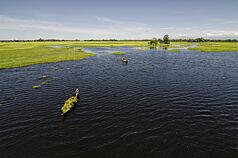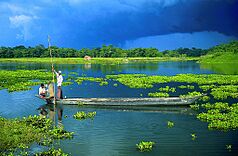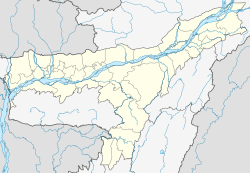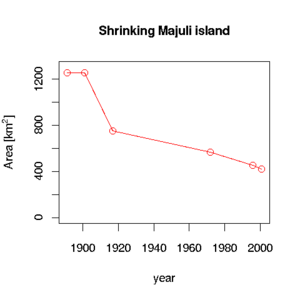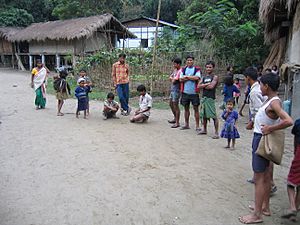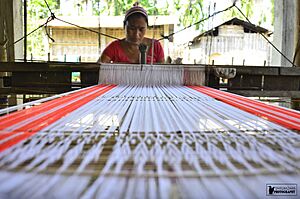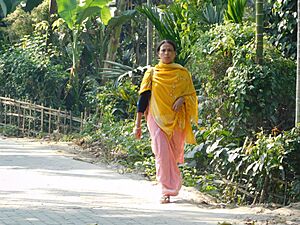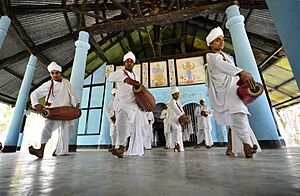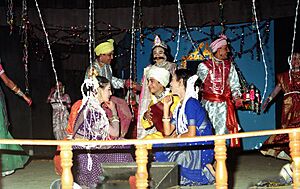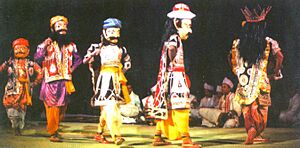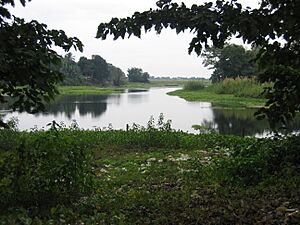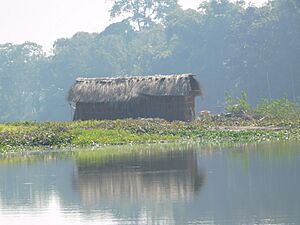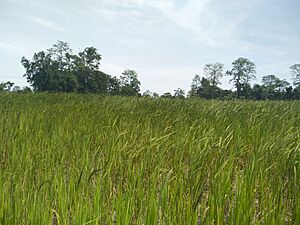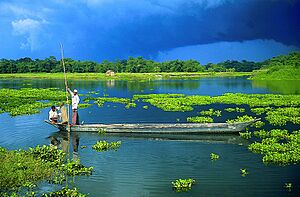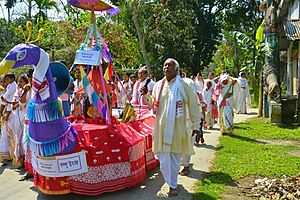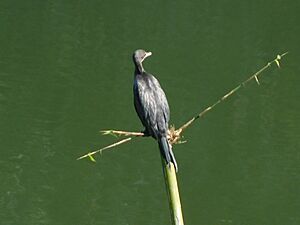Majuli facts for kids
|
From top, left to right: Doriya River of Majuli; Kherkoitia River; an anabranch of the Brahmaputra
|
|
| Geography | |
|---|---|
| Location | Brahmaputra River |
| Coordinates | 27°00′N 94°13′E / 27.000°N 94.217°E |
| Area | 352 km2 (136 sq mi) |
| Highest elevation | 84.5 m (277.2 ft) |
| Administration | |
|
Country
|
|
| State | Assam |
| District | Majuli |
| Demographics | |
| Population | 167,304 |
| Pop. density | 300 /km2 (800 /sq mi) |
| Ethnic groups | Mising, Deori, Kaibarta, Sonowal Kacharis, Koch, Ahom, Sutiya, Kalita, Brahmin, Sut, Nath(yogi) groups |
| Additional information | |
| Time zone | |
| PIN | 785102, 785104, 785105, 785110, 785106 |
| Telephone code | 03775 |
| Vehicle registration | AS-29 |
| Deputy Commissioner Cauvery B. Sharma | |
Majuli is a large river island located in Assam, India. It is surrounded by the Brahmaputra River to the south and east. To the west, you'll find the Subansiri River. A smaller branch of the Brahmaputra, called Kherkutia Xuti, forms its northern border.
This island is home to different groups of people, including the Mising, Deori, and Sonowal Kachari tribes. Majuli is also a very important place for Assamese neo-Vaishnavite culture, which is a type of Hinduism. You can reach the island by ferry from Jorhat, which is about 250 kilometers northeast of Guwahati.
Majuli faces a big challenge: the island is shrinking. This happens because of regular floods during the rainy season and changes in the river's path. In the 18th century, Majuli was about 1,300 square kilometers. By 2014, it had shrunk to only 352 square kilometers.
In 2016, Majuli made history by becoming the first island in India to be made a government district. Since 2004, UNESCO has listed Majuli on its Tentative List to become a World Heritage Site. This means it's being considered for special protection because of its global importance.
Contents
World's Largest River Island
Majuli is known as the world's largest inland river island, according to the Guinness World Records. However, another famous encyclopedia, Encyclopædia Britannica, says that Bananal Island in Brazil is the largest.
This difference in opinion comes from how people define a river island. For Bananal Island, some say the Araguaia River splits into two separate rivers that later join again. Others believe it remains one river that simply forms an island in its middle. This makes it tricky to decide which island is truly the largest.
Majuli's History
Majuli was once a long, narrow piece of land between two rivers: the Brahmaputra to the north and the Burhidihing to the south. These rivers met at a place called Lakhu. In the 17th century, between 1661 and 1696, a series of earthquakes happened. These earthquakes set the stage for a huge flood in 1750. This massive flood changed the course of the Brahmaputra River, and that's how Majuli island was formed.
In the early 1600s, the Ahom king Pratap Singha built a defensive wall, called a rampart, on Majuli. It was named Meragarh. Later, in 1776, King Lakshmi Singha wrote about "Majuli pradesh" (meaning Majuli region) and mentioned some important places there, like Kamalabari Satra and the Tuni River. During the Moamoria rebellion, a rebel leader named Howha took control of the island.
Over time, the Burhi Dihing River's meeting point moved about 190 kilometers to the east. The southern channel became known as the Burhi Xuti, and the northern channel became the Luit Xuti. Eventually, the Luit Xuti became smaller and was renamed Kerkota Xuti. The Burhi Xuti, however, grew larger and became the main Brahmaputra River we know today.
Majuli has been a very important cultural center for Assamese civilization since the 16th century. This began when Srimanta Sankardeva, a social reformer from the 1500s, visited the island. Sankardeva was a leader of the neo-Vaishnavite movement. He taught Vaishnavism and built special monasteries called satras on the island.
Majuli became a major center for Vaishnavism as more satras were built. The island was under British rule until India gained independence in 1947.
Over the last 200 years, Majuli has gotten much smaller because the river around it has grown. In the 1790s, the island covered about 1,300 square kilometers. By the early 1900s, it was 1,255 square kilometers. But because of a lot of erosion, it was only 352 square kilometers in 2014.
Culture and People
Who Lives in Majuli?
Majuli's population includes different groups of people. Many belong to scheduled tribes and castes. There are also non-tribal Hindu Assamese communities. The main native groups are the Mising (who are the majority), Deori, Kaibarta, and Sonowal Kachari tribes. These tribes moved to Majuli from Arunachal Pradesh many centuries ago.
Other communities living here include the Koch, Kalita, Ahom, Sutiya, and Jogi people. The languages spoken on the island are Mising, Assamese, and Deori. Majuli has 144 villages, with over 150,000 people living there. About 300 people live in each square kilometer.
A ferry service connects Majuli to Jorhat, running six times a day. You can also take night buses from Guwahati to Majuli, going through Lakhimpur. Even with some challenges, modern life has reached the island. There are now medical centers and schools. Homes have also changed from traditional bamboo and mud buildings to concrete ones.
Fun Festivals
The Ali aye ligang festival is a big event celebrated for five days in mid-February. It starts on the second Wednesday and ends on the first Wednesday of the Falgun month. During this festival, people enjoy local dishes like purang apin (boiled rice wrapped in leaves) and apong (rice beer). They also eat various pork, fish, and chicken dishes. The traditional Mising dance, called Gumrag Soman, is performed in every village. This dance is done to worship Donyi polo (mother sun and father moon) and ask for a good harvest.
In upper Majuli, many Christians from the Mising tribe celebrate Christmas. The main celebrations happen in the village of Jengraimukh. For the past 500 years, Majuli has been a very important cultural center for Assamese civilization. The satras (monasteries) on the island keep many old artifacts safe. These include ancient weapons, cooking tools, jewelry, and other important cultural items.
People in Majuli still make traditional pottery using clay and firing it in kilns made from driftwood. They follow methods similar to those used by the ancient Harappan Civilization. These old cultural practices and dance forms are still very much alive, even with modern changes happening around them. The hand-woven clothes made by these tribes are famous around the world.
The Raas Mahotsav festival lasts for three days. It tells the story of Krishna's life, and almost everyone on the island takes part. People come from far away, even from other countries, to celebrate. The satras have become experts in many art and craft traditions. Some of these are only found in Majuli. For example, mask-making is a special craft at Natun Samuguri Satra. Kamalabari Satra is well-known for making amazing boats.
Majuli has been the heart of Assamese neo-Vaishnavite culture for a long time. This religious movement began in the 15th century, led by the Assamese saint Srimanta Sankardeva and his student Madhavdeva. Many of the satras (monasteries) built by Sankardeva are still standing today. They show the rich Assamese culture.
Sankardeva found safety in Majuli and spent time in Belguri in West Majuli. This is where a historic meeting, called the Manikanchan Sanjog, happened when he first met Madhavdeva. Sankardeva built the first satra in Majuli in Belguri. In total, 65 satras were built on the island. However, only 22 of these are still active today. Out of 665 original satras in all of Assam, 65 were located in Majuli.
Here are some of the main Satras that are still active:
- Dakhinpat Satra: This satra was started by Banamalidev. It is famous for celebrating Raasleela, which is now one of Assam's National Festivals.
- Garamur Satra: Founded by Lakshmikantadeva, Garamur Satra has two parts: Garamur Bor Satra and Garamur Saru Satra. They celebrate the traditional Raasleela with great excitement at the end of autumn. They also keep old weapons known as "Bartop" or cannons.
- Auniati Satra: This satra was founded by Niranjan Pathakdeva. It is well-known for "Paalnaam" and Apsara Dances. It also has a large collection of old Assamese artifacts, tools, jewelry, and handicrafts. It has 125 students and more than 700,000 followers around the world.
- Kamalabari Satra: The Kamalabari Satra, started by Bedulapadma Ata, is a center for art, culture, literature, and classical studies on the island. Its branch, the Uttar Kamalabari Satra, has performed cultural shows of Satria Art across India and in other countries.
- Narasingha Satra: Shri Shri Alengi Narasingha Satra was built in 1746 by the Ahom King Promottra Singha.
- Benegenaati Satra: This satra holds many old cultural treasures and is an important center for performing arts. Muraridev, the grandson of Sankaradeva's stepmother, started this satra. It has a royal robe that belonged to the Ahom king Swargadeo Godadhar Singha, which is made of gold. A royal umbrella made of gold is also kept here.
- Shamaguri Satra: This satra is famous for making masks in India.
- Bihimpur satra Satra: These satras keep important cultural treasures like "Borgeet" (devotional songs), Matiakhara, and Satriya Dances. These dances include different styles like Jumora Dance, Chali Dance, Notua Dance, and Apsara Dance. All these forms were spread by Srimanta Sankardeva. Thanks to Pitambar Deva Goswami, these satras have also become a place for spiritual cleansing in Northeast India.
Literature
The neo-Vaishnavi teacher Madhavdev met his guru, Shankar Dev, the founder of neo-Vaishnavism, on Majuli island. This meeting is called the "Manikanchan Sanjog." Madhavdev and his teacher helped make Assamese literature richer by writing works like Nam Ghosa, Borgeet, and Bhatima. Following their lead, the temples (Satras) encouraged people to write plays and devotional songs.
Majuli has also been home to many famous writers. These include Dhruba Jyoti Borah, poet and critic Rajib Borah, and writer Bhaskar Jyoti Nath. Other notable writers are Juri Borah Borgohain, Deba Bhusan Borah, historian Dambarudhar Nath, novelist Gobin Khound, and poet Danny Gam.
The second Assamese newspaper, Asom Bilasini, was published from Majuli starting in 1871.
Majuli's Environment
Majuli is a wetland, which means it's a watery area. It is a home for many rare and endangered bird species. Many migratory birds visit Majuli during the winter. Some of these birds include the greater adjutant stork, pelican, Siberian crane, and whistling teal. After dark, wild geese and ducks fly to their resting places. The island has very little pollution because there are no factories and it gets a lot of rain.
However, Majuli faces a big problem: its banks are eroding, meaning the land is being washed away. Large walls built in nearby towns upstream to stop erosion during monsoon season have caused unexpected problems. The powerful Brahmaputra River now washes away much of the island. Reports show that in 1853, Majuli was 1,150 square kilometers. But about 33% of this land was lost to erosion in the second half of the 20th century. Since 1991, more than 35 villages have been washed away. Experts predict that Majuli might disappear within the next 15-20 years.
To save the island, the Indian government has approved about ₹ 2.50 billion (which is about US$55 million) to protect it. The water resource department and The Brahmaputra Board have been trying to solve the erosion problem for 30 years, but without much success. Recently, it was suggested that building a four-lane highway with concrete protection along Majuli's southern border could help. Also, digging out the Brahmaputra River bed might solve the problem. This plan also includes two flood gates for the Kherkatia Suti, which is a small branch of the Brahmaputra. The government has not yet started the Brahmaputra River Restoration Project. However, a request has been sent to UNESCO to declare Majuli a World Heritage Site.
A local environmental hero, Jadav Payeng, has planted a huge forest of 550 hectares. This forest, known as Molai Forest, helps fight erosion on the island. Much of the island used to be just barren sandbars that were easily washed away. But thanks to Payeng's tree planting, it has become a lush forest. This forest is now a home for animals like elephants, tigers, deer, and vultures.
Majuli's Economy
Industries
The main industry in Majuli is agriculture. Paddy (unmilled) rice is the most important crop grown here. Majuli has a rich farming tradition, with as many as 100 different kinds of rice. Fishing is also a very important industry after agriculture.
Some interesting types of rice grown include Komal Saul. This unique rice can be eaten after soaking it in warm water for just 15 minutes and is often eaten for breakfast. There's also bao dhan, which grows underwater and is harvested after ten months. And bora saul is a sticky brown rice used to make a traditional cake with fish called pitha. Fishing, dairying (making milk products), pottery, handloom weaving, and boat-making are other important ways people earn a living.
Handloom weaving is a major activity for women in the villages. Even though it's mostly not for selling, it keeps many people busy. The weaving is beautiful and detailed, using many different colors and textures of cotton and silk, especially Muga silk.
On November 4, 2017, the Chief Minister of Assam, Sarbananda Sonowal, started 647 projects. These projects had a total cost of Rs. 246 million (about US$3.3 million) and were meant to help Majuli develop.
Education
Majuli has several places for higher learning:
- Majuli University of Culture
- National Institute of Electronics & Information Technology
- Majuli College Kamalabari
- Jengraimukh College, Jengraimukh
- Ujani Majuli Kherkatia College, Nayabazar, Majuli
- Rangachahi College
- Pub Majuli College, Bongoan
- Garamur college, Garamur
Tourism
Majuli is 20 kilometers from Jorhat. You can take a bus or a taxi to the Nimati Steamer Ghat, where ferries leave. The journey takes over three hours, including three bus rides and two ferry rides.
To the north of Majuli is the Subansiri River. To the south, the mighty Brahmaputra River separates the island from the mainland. Lakhimpur town is to the north, and Golaghat is to the southwest. The town of Sibsagar is to the southeast, and Jorhat is to the south. To the far east is Dibrugarh District.
Here are some things to see and do in Majuli:
- The Vaishnava Satras founded by Sankardeva
- The colorful culture of the tribes
- Watching migratory birds
- The Ali-ai-ligang festival in February–March
- Pottery making
- Mask making
- Paal Namm festival at the end of winter
- Folgu Utsav (Holi)
- Madhya Majuli
- Namoni Majuli
- Ujoni Majuli
- Handmade masks and crafts
- Porag Utsav
- Handmade Mekhla Chadar (traditional dress)
Birdwatching
The southern part of the island is a wonderful place for bird lovers. The best time to visit is between November and March. During these months, the weather is good, and you can see many birds. Here are some great spots for birdwatching:
- The southeast of the island
- The southwest of the island
- The northern part
- Sakuli Beel, near Kamalabari
- Magurmari Beel, Dakhinpaat Satra
- Verki Beel, near Kamalabari
Transport
Majuli Port has a roll-on/roll-off (RORO) ferry service. This service uses two low-draft vessels on National Waterway 2 (NW2). They are operated by the Inland Waterways Authority of India (IWAR). These ferries can carry 200 passengers, 4 cars, and 2 trucks.
On February 18, 2021, the foundation stone was laid for a new two-lane bridge. This bridge will cross the Brahmaputra River and connect Majuli (North Bank) with Jorhat (South Bank). It will link Neematighat (on the Jorhat side) and Kamalabari (on the Majuli side).
Images for kids
See also
 In Spanish: Majuli para niños
In Spanish: Majuli para niños


